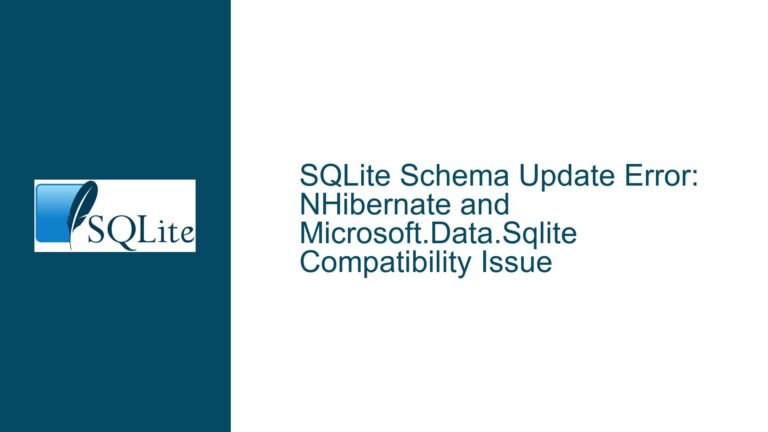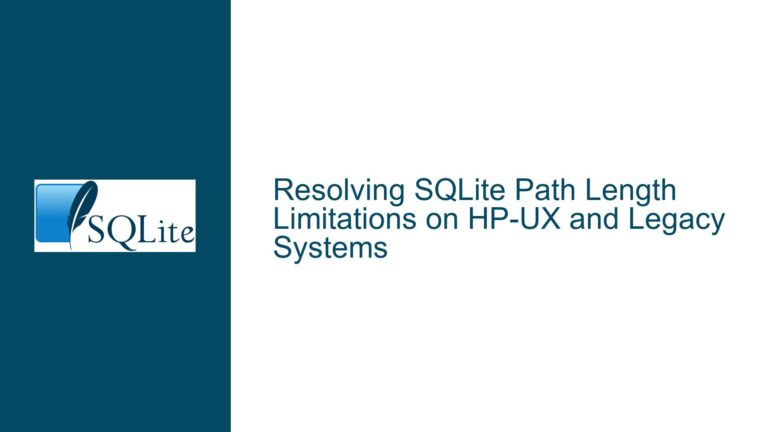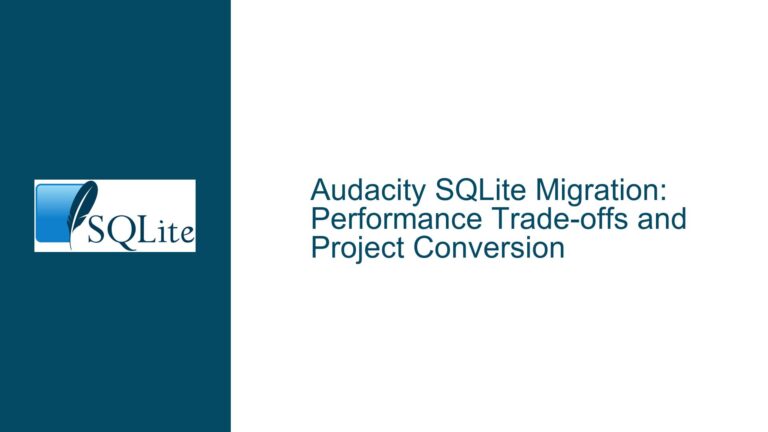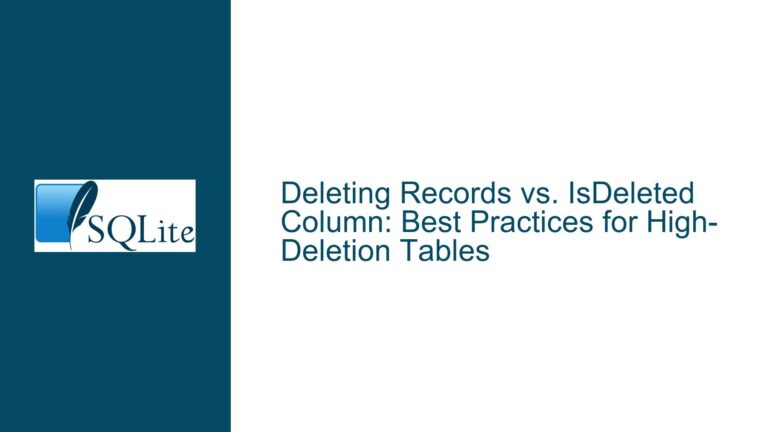Optimizing Large SQLite Databases: Sharding, Concurrency, and Maintenance Trade-offs
Understanding the Challenges of Managing a 300GB SQLite Database
When dealing with a large SQLite database of around 300GB, several challenges arise, particularly when the data is unrelated and accessed in a read-only manner. The primary concerns include the efficiency of querying, the overhead of maintaining such a large database, and the potential benefits of breaking the database into smaller, more manageable pieces. The idea of sharding the database into multiple smaller databases, each under 1GB, introduces a new layer of complexity but also offers potential performance and maintenance benefits. This approach requires careful consideration of database connection overhead, multi-threading capabilities, and the overall design pattern for read-only databases.
The core issue revolves around whether the benefits of sharding—such as reduced query times, easier backups, and improved concurrency—outweigh the added complexity of managing multiple databases. Additionally, the discussion highlights the importance of considering concurrent writing scenarios, which were initially overlooked but are crucial for a complete solution. The use of a global mapping table to manage shard-to-database relationships further complicates the design but is necessary for maintaining coherence across the shards.
Evaluating the Performance and Maintenance Implications of Database Sharding
One of the primary motivations for sharding the database is to improve query performance by reducing the number of rows each query must filter through. In a B-Tree indexed database, the time complexity for accessing a row is proportional to the logarithm of the number of rows. Therefore, reducing the number of rows in each database from 1 billion to approximately 3.3 million (by splitting the 300GB database into 100 smaller databases) could theoretically reduce the access time from a logarithmic factor in the 30s to one in the 20s. This reduction, while seemingly small, can be significant in high-throughput environments where even minor performance gains are valuable.
However, the performance benefits of sharding must be weighed against the increased complexity of managing multiple databases. Each database connection incurs a small overhead, primarily due to schema caching and other initialization processes. While this overhead is generally negligible for most applications, it can become a bottleneck in resource-constrained environments or when dealing with hundreds of simultaneous connections. Furthermore, the need to maintain a global mapping table adds another layer of complexity, as it requires additional logic to determine which database to query for a given shard.
Maintenance is another critical factor to consider. A single 300GB database can be cumbersome to back up, move, or update, especially when the updates are performed in batch jobs once per year. Sharding the database into smaller pieces can simplify these tasks, as each individual database is more manageable. However, this benefit comes at the cost of increased complexity in coordinating backups and updates across multiple databases. Additionally, the risk of data inconsistency or corruption increases with the number of databases, as each database must be individually verified and maintained.
Implementing Multi-Threading and Concurrent Access in a Sharded SQLite Environment
Multi-threading can significantly enhance the performance of a sharded SQLite database by allowing concurrent queries to be executed across different databases. Since each thread can access a separate database, the overall throughput can be increased, especially when the queries are I/O-bound. However, multi-threading introduces its own set of challenges, particularly when it comes to managing database connections and ensuring thread safety.
Each database connection should be accessed by a single thread to avoid contention and potential race conditions. This requirement means that the application must carefully manage its connection pool, ensuring that each thread has exclusive access to its assigned database. In environments where multiple threads need to access the same database, additional synchronization mechanisms, such as mutexes or semaphores, may be required to prevent conflicts.
Concurrent writing is another aspect that must be carefully considered. While the primary use case for the database is read-only, there may be scenarios where concurrent writes are necessary, such as during batch updates or when generating reports. In these cases, sharding can help reduce contention by distributing writes across multiple databases. However, this approach requires careful coordination to ensure that writes are properly synchronized and that data consistency is maintained across all shards.
The use of a global mapping table adds another layer of complexity to concurrent access. This table must be carefully designed to ensure that it can be accessed efficiently by multiple threads without becoming a bottleneck. Techniques such as caching the mapping table in memory or using a dedicated database connection for mapping lookups can help mitigate this issue. Additionally, the mapping table should be designed to handle updates gracefully, ensuring that changes to the shard-to-database relationships are propagated correctly and without causing inconsistencies.
Exploring Alternative Solutions: Server Databases and Partitioning
While sharding offers several potential benefits, it is not the only solution for managing large SQLite databases. An alternative approach is to use a server-based database system, such as PostgreSQL, which natively supports partitioning and can handle large datasets more efficiently. Partitioning allows the database to be divided into smaller, more manageable pieces, similar to sharding, but with the added benefit of being managed by the database system itself. This approach can simplify the application logic, as the database system handles the complexities of partitioning, including query routing and data consistency.
Using a server-based database during development can also provide additional flexibility, as it allows for more sophisticated querying and indexing strategies that may not be feasible with SQLite. Once the data is ready for production, it can be exported to SQLite for customer release, ensuring that the final product remains lightweight and portable. This hybrid approach combines the strengths of both database systems, leveraging the power and flexibility of a server-based database during development while maintaining the simplicity and efficiency of SQLite in production.
Conclusion: Balancing Complexity and Performance in Database Design
The decision to shard a large SQLite database involves a careful balance between performance, maintenance, and complexity. While sharding can offer significant performance benefits, particularly in high-throughput environments, it also introduces additional complexity in terms of database management, multi-threading, and concurrent access. The use of a global mapping table further complicates the design, requiring careful consideration of access patterns and synchronization mechanisms.
Alternative solutions, such as using a server-based database with native partitioning support, can provide similar benefits without the added complexity of sharding. However, these solutions may not be suitable for all use cases, particularly when portability and simplicity are key requirements. Ultimately, the choice of database design should be guided by the specific needs of the application, taking into account factors such as query performance, maintenance overhead, and the potential for concurrent access.
In summary, sharding a large SQLite database can be a viable solution for improving performance and manageability, but it requires careful planning and implementation to ensure that the benefits outweigh the added complexity. By considering the trade-offs and exploring alternative solutions, developers can design a database system that meets the needs of their application while maintaining a balance between performance and maintainability.






